Article Highlights
- Deep learning-assisted SERS enhances the analysis of urine, aiding in safeguarding kidney allografts against transplant organ tissue injuries.
- A hybrid SERS substrate crafted from gold and silver, coupled with deep learning algorithms, allows for sensitive and specific monitoring of urinary biomarkers, aiding in the differentiation of various kidney allograft injuries with an accuracy of 93.03%.
- This approach offers a promising solution for post-transplantation monitoring, potentially revolutionizing liquid biopsy-based diagnostics for allograft injuries.
Deep learning-assisted surface-enhanced Raman spectroscopy (SERS), a molecular spectroscopic technique, could help improve the analysis of biological fluids such as urine, according to a recent study published in Spectrochimica Acta Part A: Molecular and Biomolecular Spectroscopy (1). The result is that SERS could be used to safeguard kidney allografts (a transplant between genetically non-identical individuals ) against various transplant organ tissue injuries.
Organ transplants are among one of the riskier medical procedures. Kidney allograft transplants are serious specifically because the patient needing a transplant is usually in a life-threatening situation, making the transplant procedure often necessary for the patient to live. Kidney failure normally results in the need for dialysis treatment while a patient waits for an available kidney, and this process alone reduces the patient’s quality of life and imposes a higher economic cost for treatment on them (2). A recent study has documented that in the United States and Europe, only 48% are relisted for a repeat transplantation (3). A further 61% are sensitized with human leukocyte antigen (HLA) antibodies, which makes it difficult to find a suitable donor for a subsequent transplant; and the remaining patients stay dependent on dialysis until they die (3).
As a result, kidney transplants are essential for patients afflicted with kidney disease and failure. The main obstacle that clinicians face is that once a kidney is procured for transplantation, numerous threats emerge that could harm the kidney, making it not function as well, which poses risk for the patient receiving the kidney. As a result, hospitals need to have effective methods for monitoring the risk of injuries and complications for post-renal transplantation, and the issue is that most traditional laboratory tests have often fallen short in sensitivity and specificity (1). Graft biopsies have also remained invasive, fraught with complications, and are time-intensive (1).
This study, led by Hui Chen from the University of Shanghai for Science and Technology, revealed a new method that could help solve this issue. Using deep learning-assisted surface-enhanced Raman spectroscopy (SERS) for urine analysis, the research team discovered a new way to monitor the overall health of kidney allografts, which can help improve patient care.
The study revealed that the development of a hybrid SERS substrate, which was crafted from gold and silver, demonstrated great sensitivity to urine composition (1). This breakthrough simplified measurements and also yielded an abundance of intricate Raman vibrational bands, which allowed the researchers to obtain more information from the urinary biomarkers (1).
The deep learning algorithms employed in this study were important in helping to interpret the SERS signals from the urine samples. The algorithms allowed the researchers to represent the various injury types that could be encountered post-transplantation (1). These injuries include antibody-mediated rejection (AMR), BK virus nephropathy (BKVN), calcineurin-inhibitor toxicity (CNIT), delayed graft function (DGF), and T cell-mediated rejection (TCMR) (1).
Overall, the deep learning model demonstrated an overall accuracy of 93.03% in differentiating between these injury types, which shows that the method used in this study can be used as a solution to monitor kidney allografts. By amalgamating label-free SERS spectroscopy with deep learning, the study paves the way for liquid biopsy-based diagnostics of allograft injuries.
References
(1) Chen, X.; Lin, K.; Chen, K.; et al. Novel Non-invasive Method for Urine Mapping: Deep-learning-enabled SERS Spectroscopy for the Rapid Differential Detection of Kidney Allograft Injury. Spectrochimica Acta Part A: Mol. Biomol. Spectrosc. 2024, 315, 124255. DOI: 10.1016/j.saa.2024.124255
(2) Van Loon, E.; Bernards, J. Van Craenenbroeck, A.; et al. The Causes of Kidney Allograft Failure: More Than Alloimmunity. A Viewpoint Article. Transplantation 2020, 104 (2), e46–e56. DOI: 10.1097/TP.0000000000003012
(3) Rose, C.; Schaeffner, E.; Frei, U.; et al. A Lifetime of Allograft Function with Kidneys From Older Donors. J. Am. Soc. Nephrol. 2015, 26 (10), 2483–2493. DOI: 10.1681/ASN.2014080771
